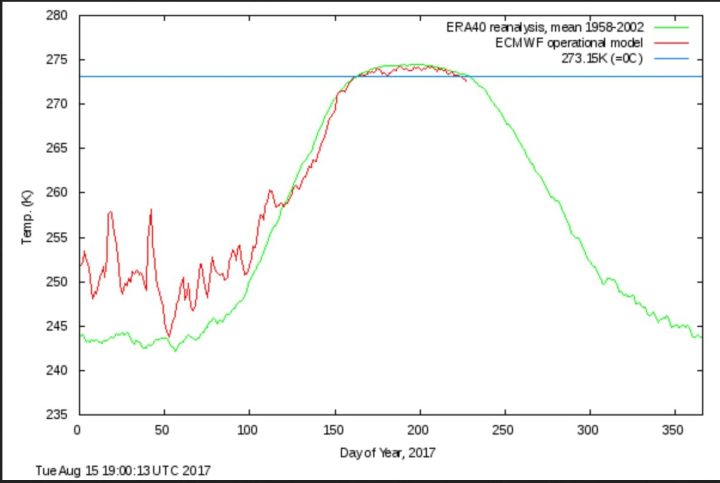Unanticipated Stability: Latest Polar Conditions Show No Signs Of Global Warming Melting
By P Gosselin on 16. August 2017
Weather and climate analyst Schneefan here writes of “early frost” in the Arctic and how Greenland snow and ice have grown after being hit by a “snow bomb”. This contradicts the expectations of global warming alarmists.
The polar summer this year appears to have ended prematurely. The mean temperature of the central Arctic above 80°N has remained under the long-term average over the entire summer and even dipped below the freezing point about a week earlier than normal (1958-2002 mean).
Source: http://ocean.dmi.dk/arctic/meant80n.uk.ph
Massive Greenland “snow bomb”
An unusually early and massive snowfall in northwest Greenland led to a record high surface snow and ice mass budget, despite the summer melt season. In one single day, 9 August 2017, the ice and snow grew by a whopping 6 billion tonnes.
The following DMI Greenland snow and ice mass budget chart clearly shows the “snow bomb” as the blue curve spikes sharply upwards. Such a spike has never been seen for this time of the year.
The upper DMI chart above shows the daily ice growth/loss since 1 September 2016 until 14 August 2017 in billions of tonnes. The lower chart shows the accumulated surface mass balance. Source www.dmi.dk/greenland-surface-mass-budget/.
Note the latest small step upward in the lower chart, which is unusual in August because it is supposed to be the melt season. The approximately 670 billion tonnes of accumulated ice mass reached last May is new record. Note that this year is some 450 billion tonnes of ice above the level of this time in 2012 (red curve).
The weather forecast for Hall Land in northern Greenland forecasts more snow on the way, after a few days of above freezing weather.
Strong Arctic sea ice growth
The Central Arctic sea ice extent this August is considerably greater than it was over the past years.
The Maisie plot shows the central Arctic sea ice extent, 14 August. This year has by a large margin the greatest extent in five years. Source: nsidc.org/data/masie/masie_plots
Passages still closed
So far this year both the Northwest and Northeast passage in the Arctic are only passable by ice breakers, as the chart below shows:





